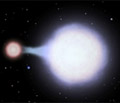Image List
-

The binary star system J0923+3028 consists of two white dwarfs that are gradually spiraling in toward each other. In about 100 million years they will merge. Since their combined mass is too low to result in a supernova (i.e. less than the Chandrasekhar limit), a single, more massive white dwarf will be left after the merger. Nuclear fusion of a shell of material on the surface will result in a flash of light like a supernova but fainter.
Clayton Ellis (CfA) -

The binary star system J0923+3028 consists of two white dwarfs: a visible star weighing 23 percent as much as our Sun and about four times the diameter of Earth, and an unseen companion weighing 44 percent of the Sun and about one Earth-diameter in size. The stars are currently separated by about 220,000 miles and orbit each other once per hour. The stars will spiral in toward each other and merge in about 100 million years.
Clayton Ellis (CfA)